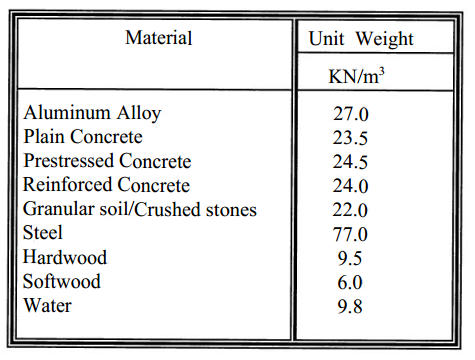Loads on Falsework and Formwork
Falsework and formwork shall be designed to carry all the loads that they will be subjected to till the time when the permanent structure they support gains sufficient strength to be self-supporting. Examples of these loads are dead loads (e.g. fresh concrete^, scaffolds, forms, etc.), live loads (e.g. workmen, equipment, tools, etc.) and environmental loads (e.g. wind, temperature effects, etc.).
Vertical Loads
These include the following:
(a) Dead Loads: These include the weight of concrete, reinforcing steel, tendons, and weight of the falsework and formwork. Table 1 provides information for unit material weights for calculating the dead loads.

Minimum loads to be assumed in design are as follows:
(i) The greater of the weight of concrete being supported, or 2.5 kN/m2 on the
horizontal projected area of the formwork.
(ii) The greater of the weight of the formwork supported by the falsework or 0.5 kN/m2 on the horizontal projected area.
(b) Live Loads: These include the weight of workmen, equipment and tools that will be supported during construction, concrete placing and finishing operations or 3.1 kN/m2 of the horizontal projected area of formwork, whichever is greater. Live loads caused by any special conditions of construction likely to occur ( e.g. unsymmetrical placement of concrete, impact, uplift, concentrated loads and the additional pressure due to placing concrete pneumatically or by pump in confined locations ) has to be considered and clearly specified on the drawings. Falsework and formwork should not be subjected to any loads that were not considered in their design such as stacked construction materials or demolition debris, heaping of concrete during the pour, etc.
Horizontal Loads
These include the following:
(a) The greater of:
(i) The calculated lateral wind forces using 1/30 probability for falsework and 1/10 probability for formwork with a gust factor of two or a minimum wind pressure of 0.8 kPa.
(ii) A horizontal force of not less than 2% of the total vertical loads or 1.5 kN per linear meter of deck edge applied at the mid-depth of the deck, whichever is greater.
(b) Lateral force components that would develop from loads applied on sloping members,
(c) Lateral forces due to the placement of fresh concrete against formwork surfaces,
(d) Any other reasonably anticipated lateral forces (e.g. post tensioning, inclined supports, impact from dumping of concrete or moving equipment, etc. ).
Concrete Pressures
When concrete is placed into forms, at first it behaves like a fluid and exerts full hydrostatic pressure on the forms. It then goes through a series of chemical changes and with the passage of time it becomes plastic and finally solid. Different layers of concrete will be in different stages of hardness. In the same concrete pour, the change from fluid to plastic and finally to solid state starts at the lower layers and progresses upward to upper layers. The gradual change in the state of concrete results in a gradual change in the amount of the lateral pressure exerted on the containing forms.
